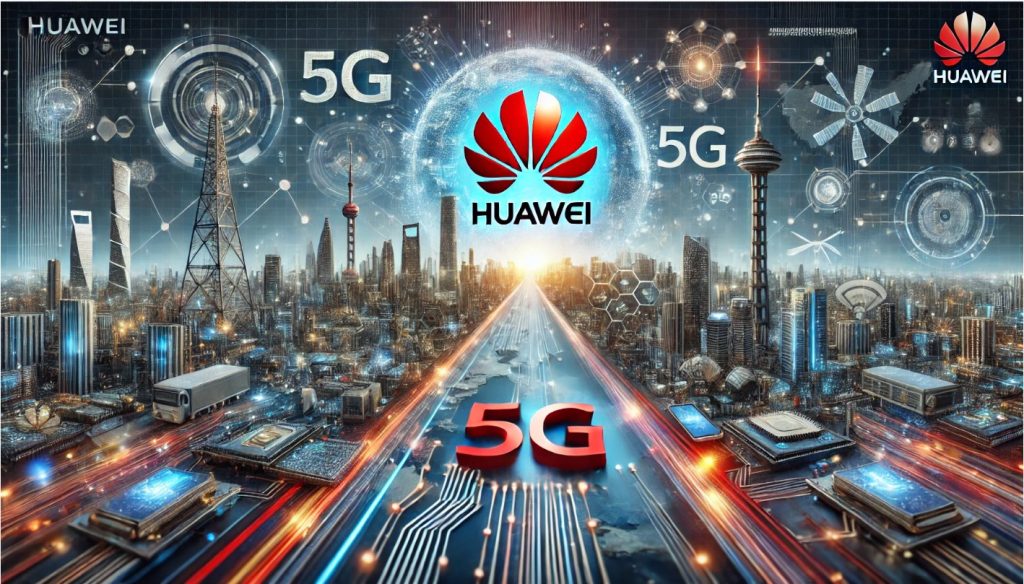China has emerged as a global leader in the development and deployment of 5G technology, with Huawei Technologies at the forefront of this technological revolution. As one of the world’s largest telecommunications equipment and consumer electronics manufacturers, Huawei has played a pivotal role in shaping the global 5G landscape. With its technological expertise and significant market share, Huawei’s efforts in 5G innovation, network infrastructure, and research and development (R&D) have positioned it as a key player in the next generation of wireless communication.
5G technology promises to transform industries, economies, and societies by offering faster data speeds, lower latency, and greater network capacity. As 5G networks become the backbone of the digital economy, they will enable advancements in fields such as autonomous vehicles, smart cities, artificial intelligence (AI), and the Internet of Things (IoT). Huawei’s role in the development of these technologies, however, has not been without controversy. The company’s rapid rise and its association with the Chinese government have raised security concerns in several countries, especially around the potential risks associated with Chinese technological dominance in critical infrastructure.
Huawei’s Role in the Development of 5G Technology
The Evolution of Huawei’s Technological Leadership
Huawei was founded in 1987 by Ren Zhengfei, a former engineer in the People’s Liberation Army. Initially focused on providing low-cost telephone switches to Chinese telecom operators, Huawei’s early growth was driven by its ability to offer competitive products at more affordable prices compared to its global competitors. Over time, Huawei shifted its focus toward becoming a leader in the global telecommunications industry by investing heavily in research and development (R&D), particularly in emerging technologies such as 5G.
By the early 2000s, Huawei had gained significant traction in mobile network infrastructure and smartphones, which laid the foundation for its future role as a major player in the development of 5G technology. Through aggressive investment in R&D, Huawei became one of the first companies to commercialize 4G LTE technology, which provided a platform for the advancement of 5G.
The company’s 5G vision was formalized in the mid-2010s as part of a broader strategy to dominate the global wireless communications market. Huawei set up 5G research labs across the globe and started working on key components of the 5G infrastructure, such as 5G chips, base stations, and antennas. The company also played an instrumental role in shaping the 5G standards through its active participation in international organizations like the 3rd Generation Partnership Project (3GPP), which is responsible for defining mobile communication standards.
5G Research and Development at Huawei
Huawei’s 5G R&D investments have been substantial, with the company investing billions of dollars into the development of next-generation wireless technologies. Huawei’s R&D budget for 5G alone has reportedly exceeded $20 billion in recent years, positioning it as one of the largest investors in wireless communications globally.
Key to Huawei’s success in 5G has been its focus on developing cutting-edge 5G chipsets. The company’s Balong series of 5G chips are integral to enabling high-speed data transmission, low-latency communications, and large-scale connectivity. These chips are designed to support a wide range of 5G use cases, from enhanced mobile broadband (eMBB) to massive machine-type communications (mMTC) and ultra-reliable low-latency communications (URLLC).
Huawei has also developed an extensive portfolio of 5G network equipment, including base stations, routers, antennas, and core network solutions. The company’s 5G core network is designed to support the virtualization of network functions and integrate technologies like network slicing and edge computing, which are critical for the efficient delivery of 5G services across a variety of industries.
By leading the charge in both hardware and software for 5G, Huawei has positioned itself as a dominant force in the 5G ecosystem.
Global 5G Race and Huawei’s Position
China’s Ambitions for 5G Leadership
China has made it clear that it intends to be the global leader in 5G technology, with Huawei as one of its flagship companies driving the country’s ambitions. The Chinese government has provided significant support to Huawei’s 5G efforts, both in terms of funding and policy. As part of its broader goal of establishing a digital Silk Road, China aims to not only dominate the 5G space but also ensure that Chinese technologies and companies are integrated into global 5G infrastructure.
The Chinese government’s Made in China 2025 initiative outlines a strategy to elevate China’s technological prowess in key sectors, including 5G communications, artificial intelligence (AI), advanced manufacturing, and biotechnology. 5G is seen as a critical component of this strategy, as it will form the backbone of China’s digital economy and its ambitious plans for smart cities, autonomous vehicles, and IoT development.
In this context, Huawei’s position as the world’s largest supplier of 5G network equipment is a reflection of the company’s close relationship with the Chinese government. The state’s support has enabled Huawei to outpace competitors in both technology development and market penetration, positioning it as a global leader in 5G deployment.
The Global 5G Race
Huawei’s dominance in the 5G sector has made it a target of international competition, particularly from the United States, Europe, and Japan, which have all sought to develop their own 5G networks and technologies. While Qualcomm, Ericsson, and Nokia are the other major players in the 5G space, Huawei’s market share in 5G network equipment is far ahead, with estimates suggesting that Huawei controls more than 30% of the global market.
However, Huawei’s position has sparked a geopolitical battle, particularly with the United States. The U.S. government has expressed serious concerns about Huawei’s close ties with the Chinese government, citing the possibility of state surveillance and cybersecurity risks. These concerns have led to widespread calls for a global ban on Huawei equipment in national 5G networks, with some countries, including the U.S., Australia, India, and the UK, either banning or restricting Huawei’s participation in their 5G infrastructure.
Despite the challenges, Huawei has continued to expand its influence in other parts of the world, particularly in Africa, Asia, and Europe, where it has signed contracts with numerous telecommunications companies for 5G deployment.
The Geopolitical Tensions Surrounding Huawei
The U.S.-China Technology War
The geopolitical tensions surrounding Huawei are a direct result of the ongoing U.S.-China trade war, which has intensified since 2018. The United States has accused China of economic espionage, intellectual property theft, and unfair trade practices. Huawei has been caught in the crossfire of this conflict, with the U.S. government placing the company on the Entity List, effectively banning American companies from supplying Huawei with key technologies, such as semiconductors and operating systems.
Huawei has denied all allegations of espionage, stating that it operates independently of the Chinese government and that its products are secure. However, the U.S. has continued to push its allies to exclude Huawei from their 5G rollouts, citing security risks and concerns about Chinese government influence over the company.
The U.S. pressure campaign against Huawei has had mixed results. While some countries have chosen to follow the U.S. lead, others, particularly in Europe and Asia, have continued to do business with Huawei. For example, Germany, Italy, and Spain have allowed Huawei to participate in their 5G infrastructure projects, although with certain restrictions in place. The global debate over Huawei’s role in 5G infrastructure has become a key point of contention in broader geopolitical relations.
The Role of European Allies
Europe has become a critical battleground in the geopolitical struggle over 5G technology, with the European Union (EU) attempting to balance economic considerations with security concerns. On one hand, Huawei offers affordable and high-quality 5G solutions that are crucial to the development of Europe’s 5G networks. On the other hand, European governments are under increasing pressure from the U.S. to exclude Huawei from their 5G infrastructure.
The EU has adopted a risk-based approach to 5G security, which allows individual member states to make their own decisions regarding the use of Huawei equipment. Some European countries, such as France and the UK, have allowed Huawei to participate in their 5G rollouts, but with restrictions on the most sensitive parts of the networks, such as core infrastructure. In contrast, other countries, such as Poland and Sweden, have taken a more cautious approach and excluded Huawei from their 5G projects entirely.
The debate over Huawei’s role in Europe’s 5G networks is far from settled, and the outcome of these discussions will have significant implications for Huawei’s future in the global 5G race.
Legal and Regulatory Challenges
Huawei has faced a growing number of legal challenges in various countries as part of the broader geopolitical dispute. The company’s founder, Ren Zhengfei, has repeatedly denied any allegations of espionage or ties to the Chinese government. However, the company’s legal troubles have escalated, particularly with the arrest of Huawei’s Chief Financial Officer (CFO), Meng Wanzhou, in Canada in 2018 at the request of the United States. Meng’s arrest has sparked diplomatic tensions between the U.S., China, and Canada, adding another layer of complexity to the geopolitical landscape surrounding Huawei.
In response to these challenges, Huawei has increased its focus on legal and regulatory compliance, emphasizing its commitment to transparency and accountability. However, the company continues to face a challenging global environment, with ongoing concerns about the security of its products and the broader implications of Chinese government involvement in its operations.
The Future of Huawei and Chinese 5G Technology
Global 5G Deployment
Despite the geopolitical challenges, Huawei remains a key player in the global 5G deployment landscape. As of 2021, the company had signed contracts for 5G network construction with more than 90 operators in over 50 countries. Huawei’s 5G solutions continue to be highly competitive, offering advanced technologies at relatively low costs, making them attractive to many developing countries.
In China, Huawei is poised to play a major role in the country’s 5G rollout, which is expected to be the largest and fastest in the world. The Chinese government has set ambitious goals for the deployment of 5G infrastructure, with plans to cover all cities and major rural areas with 5G coverage by 2025.
The development of 5G-powered applications in fields such as smart cities, autonomous vehicles, industry 4.0, and AI is expected to drive economic growth and create new business opportunities. Huawei’s expertise in 5G networking and its extensive ecosystem of partners position it well to capitalize on these opportunities in the years to come.
Technological Innovation and Competitor Challenges
The future of Huawei and Chinese 5G technology will depend on continued technological innovation. As the global 5G race evolves, Huawei’s ability to stay ahead of its competitors in terms of R&D, network infrastructure, and chip development will be critical to maintaining its leadership position.
Moreover, the emergence of 6G technology in the coming decade presents new challenges and opportunities for Huawei. As the company continues to invest in next-generation wireless communication technologies, it will likely play a central role in shaping the future of 6G.







